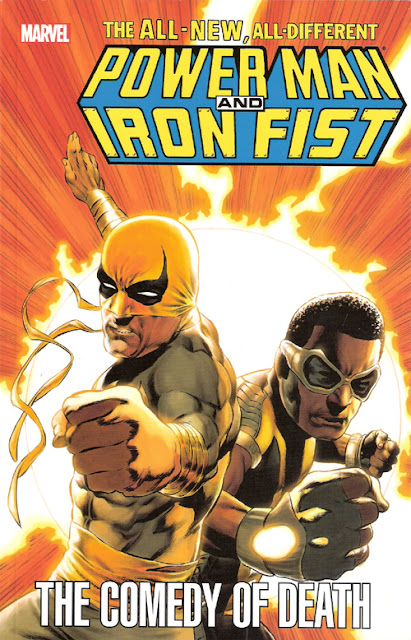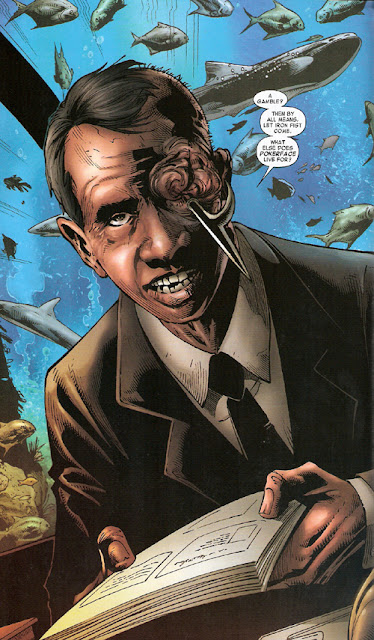Avengers Academy, v. 2: Will We Use This in the Real World?
Collects: Avengers Academy #7-13 (2011)
Released: January 2012 (Marvel)
Format: 168 pages / color / $19.99 / ISBN: 9780785144977
What is this?: The students being trained by the Avengers not to be supervillains start getting some field work.
The culprits: Writer Cristos Gage and artists Mike McKone, Sean Chen, and Tom Raney
As I mentioned in my review of Avengers Academy, v. 1: Permanent Record, Avengers Academy is a series with potential. The problem with potential, of course, is that you have eventually start delivering on it.
Writer Cristos Gage had the luxury of devoting an issue on each of the Academy’s six morally ambiguous and powerful students in v. 1, showing readers each character’s set up and establishing his or her personality. In Avengers Academy, v. 2: Will We Use This in the Real World?, he has to start developing these characters. Which way will they go — toward heroism or toward the dark side? Of course, advancing the characters doesn’t mean showing their final choices immediately; it just means they have to become something more or different than they were.
 Well, not really. For characters that are already interesting, such as the amoral and emotionally disconnected Finesse, the only thing Gage needs to do is keep the character interesting; unfortunately, Finesse gets only two character moments in this book, and one of them is fighting Taskmaster. Taskmaster may be Finesse’s father, but their skirmish reveals more about Taskmaster than Finesse.
Well, not really. For characters that are already interesting, such as the amoral and emotionally disconnected Finesse, the only thing Gage needs to do is keep the character interesting; unfortunately, Finesse gets only two character moments in this book, and one of them is fighting Taskmaster. Taskmaster may be Finesse’s father, but their skirmish reveals more about Taskmaster than Finesse.Other characters don’t get much to do either. Mettle is still a good-natured lug, trapped in an unsightly form, although he’s reaching out more toward Hazmat. Striker is still a self-centered jerk, and one incident shakes his confidence in the value of fame compared the risk involved in heroism. Reptil, the ostensible leader of the group, barely shows up until the end of the volume, when he confronts Finesse and has to decide how much his maturity is worth.
The students who get the most development are Hazmat and Veil. They (and Striker) are partners in crime in avenging the Hood’s attack on Tigra, and they share the blame. They both learn that in the future, they will not be cured (or more accurately, in a possible future, they will not be cured). Credit goes to Gage for addressing the possibility of using nullifier technology to help Hazmat, who gets a day with power-stealing mutant Leech to enjoy the world without her killing powers. She rejects Leech as a long-term therapy, seeing that she would only be using him as a crutch. Veil makes the worst decisions possible, and somehow, she comes out smelling like a rose at the end of it all. Infuriatingly, her teachers smile indulgently rather than punishing her. At least she learns some self-reliance.
The teachers get some screen time as well. Quicksilver is still his acerbic self, and he steals any scene he’s in. Justice exists, and his only real importance comes at the party in #13. Speedball is still the New Warriors martyr, and his cutting in Permanent Record is revealed to be his way of powering up for fights (yeah, right). Hank Pym becomes Giant Man again; it’s never a great sign for Pym’s mental health when he changes names, and it doesn’t help that he highlights his many names and bouts of mental instability in issue #7. On the other hand, Pym and Gage get points for mentioning the Sentry was the least mentally stable Avenger, and Pym’s moment of compassion for Absorbing Man is a nice moment for Pym.
Tigra gets a good deal of attention, although most of it revolves around her dealing with the Hood attacking her in New Avengers #35 (not footnoted), but there’s also a bit of her relationship with Hank Pym and the baby she had with Skrull Hank Pym. (Did you know she had a child? Neither did I, but it was born in Avengers: The Initiative #35. It was never mentioned in Permanent Record, though. You’d think that would be important, even if Tigra is a secondary character in this title.) She seems to be making another attempt at a relationship with Pym, which makes even less sense that it did the first two times. But what is Avengers Academy if not the refuge of heroes who make horrible, horrible choices?
I really didn’t appreciate the use of Korvac as a villain in #11 and 12. He was the antagonist for one of the most lauded Avengers stories of all time (The Korvac Saga), in which he beat a powerhouse lineup of Avengers and was defeated only because he gave up. Using him to give the Avengers Academy students a push doesn’t make the Avengers Academy kids (or their future versions) look tough; it just makes them look as if they found a loophole the defeated Avengers did not. Although in theory defeating Korvac should make the team look impressive, Korvac will return, and if we’re lucky, this story will be referenced. Honestly, I get the feeling this battle will disappear, never to be referenced outside this title again — and that’s not something that should happen with a conflicted, powerful character like Korvac.
The final issue in Real World features a party that includes the Young Allies and some members of The Initiative as guests. In theory, this is an outstanding idea; it increases the dating pool, and gives the characters non-psychopathic colleagues and peers to interact with. On a practical level … I’m not so sure. It does give readers some closure on the Firestar / Justice romance that we’ve needed for a long time, and it allows some romantic subplots to move forward. However, having the students attend the dance in their costumes is an awful choice, emphasizing the artificiality of the setup. What kid would want to go to a dance in their work clothes or form-fitting spandex? If they wanted to conceal their identity, they should have gone with domino masks or some other contrivance.
More importantly, some of the interactions in #13 are predicated upon knowing what happened in the Young Allies / Avengers Academy crossover, Avengers Academy: Arcade: Death Game (also not footnoted). With a name like that, you would think it would have been included in the numbering of Avengers Academy volumes. Unfortunately, it wasn’t, and it doesn’t include any issues of the regular Avengers Academy or Young Allies series; instead, the book has the double-sized Avengers Academy Giant-Size and two reprint issues featuring the villain Arcade. I am not paying $15 to buy that (or even $3 to interlibrary loan it). That’s not Gage’s fault, I suppose, but it does put a slight crimp in my enjoyment.
As for the art in Real World… Oh, Mike McKone. I didn’t care for his work in Permanent Record, and I liked it less in Real World. McKone pencils #8 and 9, and he has the same odd spacing of characters in close ups that make them look as if they are about to kiss, regardless of the emotions between the characters. He has Tigra wearing more to bed (a t-shirt) than she wears in public. The cover for issue #8 (featured on the back cover) features Finesse seemingly leaning backwards to display her breasts; unfortunately, to get that angle, her neck is doing impossible things to put her head forward.
 More importantly, his art for the battle between Finesse and Taskmaster is lacking. With two characters who can mimic the fighting style of anyone they see, McKone can do anything, show all sorts of crazy attacks. But what McKone actually shows are the moments between the attacks. Finesse disarms Taskmaster of his sword; how? I don’t know. A panel shows her kicking it, but it’s already out of Taskmaster’s hand by the time that happens. Taskmaster disarms Finesse right back, probably with a shield bash, but it’s hard to reconcile with the panel before it. Taskmaster chokes Finesse with a lariat; how did he get it around her neck? At one point, Taskmaster throws his shield at Finesse … and misses. A man who has copied Captain America, fighting an inexperienced opponent, just misses. That’s a horribly missed opportunity.
More importantly, his art for the battle between Finesse and Taskmaster is lacking. With two characters who can mimic the fighting style of anyone they see, McKone can do anything, show all sorts of crazy attacks. But what McKone actually shows are the moments between the attacks. Finesse disarms Taskmaster of his sword; how? I don’t know. A panel shows her kicking it, but it’s already out of Taskmaster’s hand by the time that happens. Taskmaster disarms Finesse right back, probably with a shield bash, but it’s hard to reconcile with the panel before it. Taskmaster chokes Finesse with a lariat; how did he get it around her neck? At one point, Taskmaster throws his shield at Finesse … and misses. A man who has copied Captain America, fighting an inexperienced opponent, just misses. That’s a horribly missed opportunity.On the other hand, I was able to identify minor crimelord the Slug just from McKone’s art. So there is that.
I enjoyed the other artists much more, and I would very much like to see more of them (and less of McKone). Tom Raney penciled #7 and 11-12; he’s been a good artist for quite a while. I liked his work with the size-changing Pym, but his adult Reptil didn’t look old enough — more like a college student with a goatee than a 30-year-old. He really needed to put more work in on the redesigns of the students’ future versions; evidently, all that will change is that the males who can will grow goatees and Hazmat and Finesse will get slight changes to their costumes. Sean Chen was my favorite, as I enjoyed the tight, controlled line of his artwork, and he was able to handle the quiet conversations and crowded party scenes in #13 equally well. I can’t decide whether Hazmat and Leech’s mysteriously unexplained transportation from New York to San Francisco and back in an afternoon is his fault or Gage’s (teleportation? Infinite mansion? Quinjet?).
Gage continues to develop some of the new characters, even if in Real World it’s only Hazmat and Veil. Unfortunately, between Korvac and Finesse’s pointless fight and Tigra’s less than satisfactory moments, there are some questionable plot choices. There is still hope for the future, though.
Rating:
Labels: 2, 2012 January, Avengers Academy, Cristos Gage, Finesse, Hank Pym, Hazmat, Marvel, Mettle, Mike McKone, Quicksilver, Reptil, San Francisco, Sean Chen, Striker, Tigra, Tom Raney, Veil







 (0.5 of 5)
(0.5 of 5)



